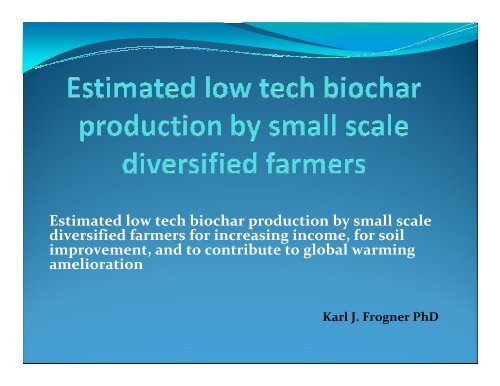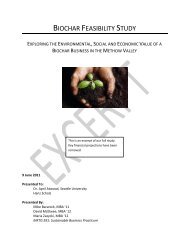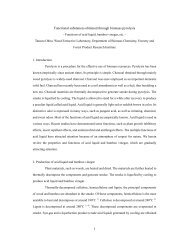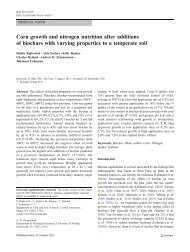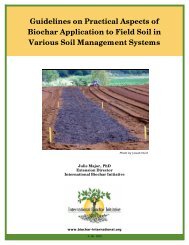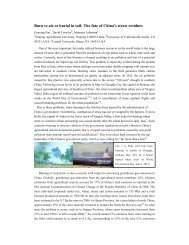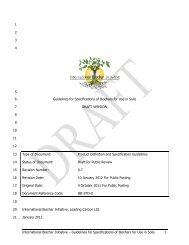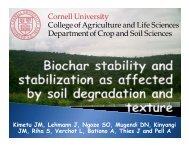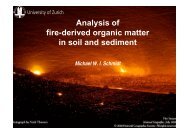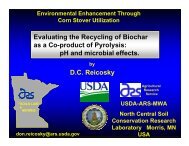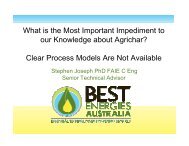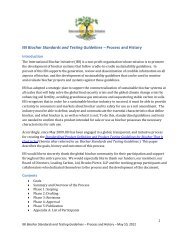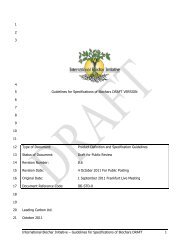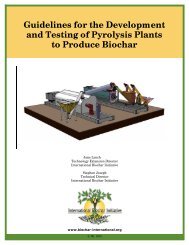Estimated low tech biochar production by small scale diversified ...
Estimated low tech biochar production by small scale diversified ...
Estimated low tech biochar production by small scale diversified ...
Create successful ePaper yourself
Turn your PDF publications into a flip-book with our unique Google optimized e-Paper software.
<strong>Estimated</strong> <strong>low</strong> <strong>tech</strong> <strong>biochar</strong> <strong>production</strong> <strong>by</strong> <strong>small</strong> <strong>scale</strong><br />
<strong>diversified</strong> farmers for increasing income, for soil<br />
improvement, and to contribute to global warming<br />
amelioration<br />
Karl J. Frogner PhD
Ulaanbaatar Biochar Initaive<br />
UBI<br />
• Biochar in sustainable rural development<br />
• Global warming amelioration through CO2<br />
sequestration via <strong>low</strong> <strong>production</strong>, high<br />
replication <strong>low</strong> <strong>tech</strong> <strong>biochar</strong> <strong>production</strong><br />
• Income enhancement through equitable<br />
compensation for labor expended in removal and<br />
sequestration of CO2 pollution.
Income Enhancement<br />
•Increased sustainable crop <strong>production</strong><br />
do to the soil conditioning attributes<br />
of sequestered <strong>biochar</strong><br />
•Compensation for carbon credits<br />
earned.
Marketing Coops<br />
•Aggregate members <strong>biochar</strong><br />
sequestration carbon credits<br />
•Monitor quantity, quality and<br />
sequestration of members <strong>biochar</strong><br />
<strong>production</strong><br />
•Pass on credits to broker and pass<br />
back payment to members
Simple Pass-through Brokerage<br />
•Simple “cost plus” bookkeeping<br />
brokerage<br />
•No brokerage project investment<br />
•Sustainable rural communities<br />
developed in cooperation with<br />
governmental and not-for-profit NGO<br />
programs
Offset pricing<br />
1 Currently would be restricted to the unregulated<br />
online trading.<br />
• Price/ton varies widely at any given time. I am taking<br />
$50/ton of carbon. (Based on: Ecobusinesslinks.com Carbon Offset<br />
Survey (26 Oct 2007) data.)<br />
2 Expected price if <strong>biochar</strong> sequestration is generally<br />
accepted and included in Cap & Trade schemes,<br />
Carbon offset trading and a legitimate use of carbon<br />
tax and the US becomes fully engaged ‐ $250/ ton of<br />
carbon. (Based on: A handful of carbon. Johannes Lehmann, May 2007;<br />
Nature (447): 143-4
THAI BIOCHAR INITIATIVE<br />
(TBI)<br />
A pilot project to test the feasibility of utilizing<br />
<strong>biochar</strong> <strong>production</strong> <strong>by</strong> <strong>small</strong> <strong>scale</strong> Thai<br />
<strong>diversified</strong> farmers for increasing income, for soil<br />
improvement, and to contribute to global<br />
warming amelioration
Agroforestry<br />
• Integrated openfield agriculture together with<br />
silvaculture and community managed forest.<br />
• Patterned after the established sustainable<br />
agroforestry community at Nakon Sawan, Thailand.<br />
(Ecosystem Restoration with Agroforestry and Community Forests In<br />
Nakhon Sawan, Thailand. Amanda Suutari and Andrew Mittelman.<br />
http://www.ecotippingpoints.org/indepth/thailandforest.html )<br />
• Average Thai <strong>small</strong> agroforester manages about 3 ha.<br />
Here apportioned as: 1 ha in maize, 1 ha in rice and 1<br />
ha in mixed agroforestry, with the agroforestry<br />
cumulatively apportioned as 25% biomass crop and<br />
75% crops for which only prunings would be available<br />
for <strong>biochar</strong>. (Andy Mittelman, perrs comm.)
Stouffer<br />
Table 1. Per ha value as CO2 offset of 8 crop residues produced in Thailand in 1990<br />
[after: Inventory 1990 Field Burning of Agriculture Residue Sector<br />
http://www.onep.go.th/projects/climate/comm/inventory/burning/intro.html]<br />
Residue t Residue/ha % dry wt value @ CO2 offset (US $)<br />
$16.5 $ 85.0<br />
Rice : North 3.1 0.85 46.0 230.0<br />
Rice : NEast 1.9 0.85 28.0 141.5<br />
Rice : Mid 4.4 0.85 65.5 327.0<br />
Rice : South 3.1 0.85 46.0 230.0<br />
Maize 3.1 0.40 21.5 108.5<br />
Sorghum 4.4 0.94 72.5 362.0<br />
Cassava 4.4 0.70 54.0 269.5<br />
Sugar cane 1.7 0.71 21.0 105.5<br />
Mungbean 1.9 0.80 26.5 133.0<br />
Soybean 3.1 0.91 49.5 247.0<br />
Groundnut 3.8 0.80 53.0 266.0
Biomass cropping & prunings<br />
Table 2. An indication of per ha value as CO2 offset of woody biomass productivity<br />
[After: Sustainability and reality of the projects of Carbon sequestration <strong>by</strong> Carbonization and Forestation (CCF) as a<br />
biomass conversion option. By: Makoto Ogawa, Yasuyuki Okimori, Fumio Takahashi.]<br />
Pulpwood field process pulp above ground<br />
Silvacultuer residue residue product field biomass<br />
dry wt t/.125ha/yr 6.2 0.8 19.9 26.9<br />
----------------------------<br />
value @ CO2 offset<br />
$16.5 $108 $14 $ 348 $ 471<br />
$85.0 542 70 1741 2354
Potential Income Increase<br />
If our hypothetical farmers were to be managing 18 rai<br />
as 1 ha in maize, 1 ha in rice and 1 ha in mixed<br />
agroforestry, with the agroforestry cumulatively<br />
apportioned as 25% biomass crop and 75% crops for<br />
which only prunings would be available for <strong>biochar</strong>,<br />
then from the rice straw and maize field residue and<br />
the agrforestry prunings and biomass harvest they<br />
could expect to produce 4.68 t of <strong>biochar</strong> (at 35% dr<br />
wt yield). At current and potential prices ($50 & $250)<br />
and a 65% to 85% pass back the farmer could expect<br />
an additional $150 to $1,000 (where $5 ‐ $10/da for 300da =<br />
$1,500 to $3,000)


